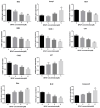Bisphenol AF Induced Neurodevelopmental Toxicity of Human Neural Progenitor Cells via Nrf2/HO-1 Pathway
- PMID: 40565148
- PMCID: PMC12193609
- DOI: 10.3390/ijms26125685
Bisphenol AF Induced Neurodevelopmental Toxicity of Human Neural Progenitor Cells via Nrf2/HO-1 Pathway
Abstract
Bisphenol AF (BPAF) is widely utilized as an analog of bisphenol A (BPA) in the plastics industry. However, there is limited evidence on its neurodevelopmental toxicity. Existing studies suggest that BPAF has greater accumulation in vivo than other bisphenol analogs, and could pass through the placental barrier and the blood-brain barrier. In this study, we used the human neural progenitor cells line ReNcell CX, which was derived from 14-week human cortical brain tissue, as an in vitro model to investigate the neurodevelopmental toxicity effects of BPAF and BPA on ReNcell CX cells, and explored the possible mechanism by which BPAF induced neurodevelopmental toxicity on ReNcell CX cells. The results showed that BPAF reduced the proliferation of neural progenitor cells and changed the differentiation towards neurons after exposure for 24 h. Compared with BPA, ReNcell CX cells are more susceptible to BPAF exposure. In a 3D neurospheres model, BPAF affected the distance that neurons migrated outwards at the concentration of 2 μM. Furthermore, BPAF increased ROS levels in cells and reduced the expression of key proteins in the Nrf2/HO-1 pathway and its downstream molecules, such as SOD, GSH, and CAT. In conclusion, BPAF induces damage to critical nodes in neural progenitor cell development through the Nrf2/HO-1 pathway. Therefore, clarifying its neurodevelopmental toxicity and elaborating on the neurodevelopmental toxicity effects and mechanisms of bisphenol AF will help identify intervention targets for neurodevelopmental toxicity, and will have important public health significance for the safety assessment and risk prediction of bisphenol-related chemicals.
Keywords: BPAF; Nrf2/HO-1 pathway; ReNcell CX cells; neurodevelopmental toxicity.
Conflict of interest statement
The authors declare no conflicts of interest.
Figures






Similar articles
-
Silymarin attenuates post-weaning bisphenol A-induced renal injury by suppressing ferroptosis and amyloidosis through Kim-1/Nrf2/HO-1 signaling modulation in male Wistar rats.Biochem Biophys Res Commun. 2025 Apr 12;758:151668. doi: 10.1016/j.bbrc.2025.151668. Epub 2025 Mar 19. Biochem Biophys Res Commun. 2025. PMID: 40120348
-
Bisphenol AF (BPAF) jeopardizes male fertility and triggers intergenerational defects in zebrafish (Danio rerio).Comp Biochem Physiol C Toxicol Pharmacol. 2025 Nov;297:110278. doi: 10.1016/j.cbpc.2025.110278. Epub 2025 Jul 7. Comp Biochem Physiol C Toxicol Pharmacol. 2025. PMID: 40633706
-
Bisphenol A and bisphenol AF co-exposure induced apoptosis of human ovarian granulosa cells via mitochondrial dysfunction.Food Chem Toxicol. 2024 Sep;191:114894. doi: 10.1016/j.fct.2024.114894. Epub 2024 Jul 27. Food Chem Toxicol. 2024. PMID: 39074574
-
Signs and symptoms to determine if a patient presenting in primary care or hospital outpatient settings has COVID-19.Cochrane Database Syst Rev. 2022 May 20;5(5):CD013665. doi: 10.1002/14651858.CD013665.pub3. Cochrane Database Syst Rev. 2022. PMID: 35593186 Free PMC article.
-
Mechanisms of bisphenol A and its analogs as endocrine disruptors via nuclear receptors and related signaling pathways.Arch Toxicol. 2025 Jun;99(6):2397-2417. doi: 10.1007/s00204-025-04025-z. Epub 2025 Mar 21. Arch Toxicol. 2025. PMID: 40116906 Free PMC article. Review.
References
MeSH terms
Substances
Grants and funding
LinkOut - more resources
Full Text Sources
Miscellaneous

